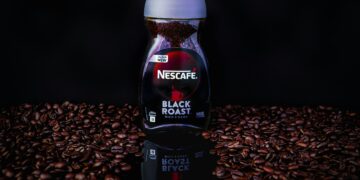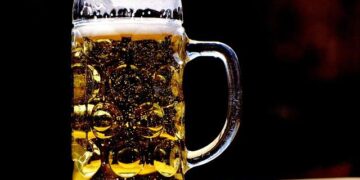Table of Contents
My name is Alex, and for years, I was trapped in a cycle of hope and disappointment.
As someone who has dedicated a significant part of my life to understanding and appreciating coffee, from its agricultural roots to the final pour, I hold a deep respect for the craft.
Yet, my daily reality often involves a compromise: convenience.
And in the world of coffee, convenience is a kingdom ruled by Starbucks.
My struggle was specific and maddeningly consistent: I just wanted a good cappuccino.
Not a great one, not an artisanal one flown in from a Roman café, just a good one.
A drink that respected its own name.
Instead, I was served a series of impostors.
Some days, it was a cup that felt suspiciously heavy, a latte in all but name, with a whisper of foam dissolving on top.1
Other days, it was a bizarre concoction of scalded milk with a soapy, bubbly texture that tasted faintly of burnt plastic.2
I’d order a “dry cappuccino,” hoping to signal my desire for foam, only to receive the same milky brew, or worse, a cup that was genuinely half-empty with a collapsing head of airy bubbles.3
Each visit was a gamble, and I almost always lost.
This wasn’t just about a bad drink; it was a paradox that gnawed at me.
How could the largest, most systematized coffee company on the planet, a corporation that built an empire on espresso-based beverages, be so fundamentally incapable of producing one of its most classic offerings with any degree of consistency? Why was ordering a cappuccino at Starbucks like rolling dice? This question launched me on a quest—a journey to understand not just the drink, but the system that produced it.
I needed to deconstruct the problem, find the root cause, and, hopefully, discover a solution.
This is the story of how I went from a frustrated customer to a systems analyst, and how I finally cracked the code to getting a genuinely good cappuccino from the last place I expected to find one.
Part I: The Anatomy of a Perfect Cappuccino: Establishing the Gold Standard
Before I could solve the problem of the bad cappuccino, I first had to precisely define what makes a good one.
My frustration wasn’t just a matter of personal taste; it was a deviation from a well-established, classic standard.
To understand the failure, I had to first master the blueprint.
I dove back into the history and science of the drink, establishing a “gold standard” against which all my future attempts would be measured.
The Italian Origin Story
The cappuccino’s story begins not with a recipe, but with a color.
The name itself, which appeared in Italian writings in the 19th century, is a nod to the Capuchin friars (cappuccini), whose brown hooded robes resembled the color of coffee mixed with a few drops of milk or cream.4
This early version, known as a
Kapuziner in Vienna, was a simple coffee and milk beverage.4
The modern cappuccino, the espresso-based drink we know today, was born in Italy in the early 20th century with the popularization of the espresso machine.6
Traditionally, it is a breakfast-only affair in Italy, consumed before 11 A.M. and never with a meal, as the milk is considered too heavy for later in the day.4
This cultural context is important; it frames the cappuccino as a small, potent, and carefully constructed morning ritual, not a 20-ounce afternoon behemoth.
The Sacred Trinity (The 1:1:1 Ratio)
The most fundamental characteristic of a traditional cappuccino is its composition.
It is a drink built on the principle of thirds, a harmonious balance of three equal parts: one-third espresso, one-third steamed milk, and one-third milk foam.4
This isn’t a loose guideline; it is the very definition of the drink.
This sacred trinity ensures that no single element overpowers the others.
The espresso provides the bold coffee flavor, the steamed milk adds creamy sweetness, and the foam contributes a light, airy texture and a luxurious mouthfeel.7
When you sip a true cappuccino, you should experience all three layers at once, a complex and integrated sensation that is entirely unique.
The Matter of Volume (The 6-Ounce Rule)
The strict 1:1:1 ratio directly dictates the drink’s size.
A traditional Italian cappuccino is a small beverage, served in a cup that is approximately 150 to 180 ml (about 5 to 6 US fl oz) in total volume.4
This small size is a direct consequence of its balanced recipe.
A standard single shot of espresso is about 25-30 ml (1 oz).4
To maintain the 1:1:1 ratio, this requires an equal amount of steamed milk and an equal volume of foam, naturally resulting in a 5-to-6-ounce drink.
As the World Barista Championship (WBC) rules specify, a competition-standard cappuccino is a “5–6 oz coffee and milk beverage”.10
This constraint is not arbitrary; it’s a structural necessity.
Attempting to create a much larger cappuccino fundamentally breaks the ratio and, therefore, breaks the drink itself, turning it into something else entirely—usually a latte.
The Science of Foam (Velvety Microfoam)
The crowning glory of a cappuccino is its foam, but not all foam is created equal.
There is a vast difference between the stiff, dry, bubbly foam that resembles soap suds and the silky, dense, and stable foam known as “microfoam”.2
Microfoam is the goal of any skilled barista.
It’s created by introducing tiny air bubbles into the milk while steaming, resulting in a texture that is velvety, glossy, and so fine that the individual bubbles are almost invisible.6
Achieving this texture is a science.
It requires starting with very cold, fresh milk, as this gives the barista more time to incorporate air before the milk gets too hot.6
The type of milk is also critical.
Whole milk is the traditional choice because its higher fat content creates a creamier, more stable, and more flavorful foam.5
The steaming process itself is a skill, involving precise placement of the steam wand just below the surface of the milk to create a vortex, stretching the milk until it has doubled in volume and reached an ideal temperature of around 140-160°F (60-70°C).7
Overheating the milk scalds it, destroying its natural sweetness and creating a burnt taste.2
This luxurious cap of microfoam should be thick enough to act as an insulator, keeping the drink hot, and to leave a delightful “milky moustache” after a sip.9
The Flavor Foundation (The Espresso)
Underpinning the entire beverage is the espresso.
A cappuccino’s flavor profile is defined by the intense coffee base cutting through the rich milk.
Authentic Italian cappuccinos typically use a medium to dark roast, which provides the robust, low-acidity flavors of chocolate, caramel, and nuts that pair beautifully with milk.5
The espresso shot must be pulled correctly—not too fast (under-extracted and sour) and not too slow (over-extracted and bitter).
A well-pulled shot will have a beautiful layer of reddish-brown crema, the emulsified oils that add aroma, body, and a lingering aftertaste to the drink.
This gold standard became my benchmark.
A 6-ounce drink, built on a 1:1:1 ratio of rich espresso, sweet steamed whole milk, and a cap of velvety microfoam.
It was a self-contained, perfectly balanced system.
And it was a world away from the disappointing cups I was getting every day.
Part II: The Starbucks Paradox: Deconstructing the Disappointment
Armed with a clear definition of what a cappuccino should be, I turned my attention to the central mystery: why was the Starbucks version so consistently wrong? My investigation revealed that the disappointing drink in my hand wasn’t an accident or the fault of a single lazy barista.
It was the logical, predictable output of a massive global system optimized for entirely different goals: speed, scale, and the avoidance of customer conflict.
The Starbucks cappuccino isn’t a failed attempt at a traditional cappuccino; it is, in many ways, a different beverage altogether.
To illustrate this chasm, consider the fundamental differences between the classic ideal and the Starbucks standard.
Table 1: The Cappuccino Divide: Traditional vs. Starbucks Standard
| Attribute | Traditional Italian | Starbucks Standard (Grande) |
| Size | 5-6 oz (150-180 ml) 4 | 16 oz (473 ml) 17 |
| Espresso:Milk:Foam Ratio | 1:1:1 7 | Highly variable, often closer to 1:7:8 18 |
| Foam Texture | Velvety, dense microfoam 5 | Often thin, bubbly, or latte-like 1 |
| Default Roast | Medium to Dark 5 | Very Dark Signature Roast (often described as “burnt”) 20 |
| Primary Goal | Flavor balance and texture 10 | Speed, consistency of process, and perceived value 3 |
This table makes the problem starkly clear.
The Starbucks version isn’t just a scaled-up replica; it’s a drink built on a different foundation.
The reasons for this divergence are systemic, woven into the company’s operational D.A.
The Systemic Culprits
My journey into the “why” led me to three core areas where the Starbucks system prioritizes its own needs over the craft of coffee: equipment, training, and its core philosophy on coffee roasting.
- Equipment & Speed: In a high-volume environment like Starbucks, every second counts. The steam wands on their espresso machines are powerful and largely automated, designed to heat milk to a preset temperature as quickly as possible.1 While efficient, this speed is the enemy of good foam. Creating velvety microfoam requires a delicate touch and a bit more time to properly aerate the milk before it gets too hot.14 The Starbucks steam wands often heat the milk so fast that there’s insufficient time to create a stable foam structure, resulting in either large, soapy bubbles that quickly collapse or, if the barista doesn’t aerate enough, simply hot milk with a thin, latte-like topping.1 The equipment is built for throughput, not for artistry.
- Training & Morale: Starbucks’ training regimen, as described by many current and former baristas, understandably prioritizes speed, memorization of complex recipes for sweetened drinks, and adherence to a standardized workflow.1 The nuanced, tactile skill of steaming perfect milk is often given less emphasis because it’s time-consuming and difficult to standardize.1 In a high-pressure environment with long lines and a focus on “drive-thru times,” many baristas simply don’t have the time, training, or incentive to focus on perfecting a classic cappuccino.1 This can be compounded by low morale, where the emphasis on beverage quality takes a backseat to just getting through the rush.1
- The Roast Philosophy: Perhaps the most fundamental issue starts with the beans themselves. Starbucks is famous for its very dark roast profile. From a business perspective, this makes sense: roasting beans to a dark, carbonized state masks the flavor variations of the underlying green coffee, making it easier to achieve a consistent taste profile in thousands of stores globally.20 However, this process also obliterates the delicate, sweet, and nuanced flavors of the coffee, replacing them with roasty, bitter, and often “burnt” notes.20 This means that even with a perfectly pulled shot and perfectly steamed milk, the foundational flavor of a Starbucks cappuccino is often harsh and bitter, a far cry from the rich, chocolatey notes of a traditional Italian roast. Many critics argue that this business model is predicated on selling milky, sugary drinks because the base coffee itself is unpalatable on its own.20
The Customer Feedback Loop of Doom
The final, and perhaps most powerful, force shaping the Starbucks cappuccino is the customer.
A vicious cycle of misunderstanding and appeasement has created a reality where making a correct cappuccino is often punished, while making an incorrect one is rewarded.
The cycle works like this: A customer, unfamiliar with the light, airy nature of a true cappuccino, orders one.
The barista makes it correctly, resulting in a 16-ounce cup that feels light for its size because a significant portion of its volume is foam.17
The customer picks up the cup, feels its lightness, and immediately thinks they’ve been ripped off.
They complain that their cup is “half-empty” or “has too much foam”.3
This is a common and frustrating experience for baristas.19
To avoid this inevitable and time-consuming conflict, many baristas learn to preemptively make the drink “wrong.” They use less foam and more steamed milk, handing the customer a heavier cup that feels more substantial—a drink that is, for all intents and purposes, a latte.1
The customer, receiving what they
think a cappuccino should be, is satisfied.
This interaction has a devastating effect.
It reinforces the public’s incorrect definition of a cappuccino.
It trains customers to expect a heavy, milky drink.
And it creates an environment where the well-meaning barista who tries to uphold the classic standard is the one who gets complaints, while the one who serves a latte-in-disguise gets a happy customer.
The system, through this feedback loop, actively selects for the “wrong” output because it’s the path of least resistance.
The inconsistency I was experiencing wasn’t random; it was the result of a daily tug-of-war between the official recipe, the pressures of the system, and the expectations of the average customer.
Part III: The Epiphany: Ordering Coffee is an Act of Precision Communication
For years, I was a victim of this system, a passive recipient of its flawed outputs.
I would place my order—”one grande cappuccino, please”—and hope for the best, as if I were wishing on a star.
My approach was based on the flawed assumption that I was communicating with an artisan, a craftsperson who would hear the word “cappuccino” and understand the rich history and specific technique implied by that single word.
My frustration peaked on one particularly memorable day.
I had ordered my usual, and what I received was a cup of what can only be described as hot milk.
It was pale, heavy, and when I took a sip, the taste of coffee was so faint as to be imaginary.
There was a thin layer of sad, dissipating bubbles on top, but no substance, no texture, no soul.
In a moment of exasperated curiosity, I found a sink and poured it O.T. The liquid that flowed into the drain was stark white.
There was no coffee in it at all.27
The barista, in the rush of the morning, had simply forgotten to add the espresso shots.
But the more shocking realization was that the drink
looked almost identical to the milky, coffee-flavored beverages I was usually served.
This was my tipping point.
I realized my entire approach was wrong.
I wasn’t ordering coffee; I was submitting a vague request to a complex, automated system and being surprised by the default output.
That’s when the epiphany struck, an idea borrowed from the seemingly unrelated worlds of engineering and computer science: Precision Communication.
In these fields, ambiguity is the enemy of success.
You don’t tell a software engineer to “build an app”; you provide a detailed technical specification outlining every feature, function, and user interaction.
You don’t tell an architect to “design a building”; you provide blueprints that specify every measurement down to the millimeter.
Vague inputs lead to catastrophic failures.
The responsibility for clarity lies not with the system that executes the command, but with the person who issues it.28
I realized I had been treating the Starbucks barista as an artist when I should have been treating them as a highly skilled operator of a complex machine.
The barista is the human interface for the Starbucks system.
The system has its own language, its own set of rules, and a series of default settings designed to satisfy the most common (and often least informed) customer request.
My order, “one cappuccino,” was a vague command.
The system processed it and delivered the default: a large, milky, foam-light beverage designed to avoid the “my-cup-is-half-empty” complaint.
To get a different result—a non-standard, high-quality output—I couldn’t rely on the barista to read my mind.
I had to override the system’s defaults.
I needed to stop making a request and start giving a series of precise, unambiguous commands.
I had to learn to speak the system’s language.
This reframing was a revelation.
The problem wasn’t that Starbucks couldn’t make a good cappuccino.
The problem was that I wasn’t telling them to.
My frustration was a direct result of my own imprecise communication.29
This insight extended far beyond coffee.
It was a lesson in navigating the countless standardized systems of modern life.
Whether dealing with a call center, an online form, or a government agency, success often depends on understanding the system’s rules and providing clear, specific inputs that guide it toward your desired outcome.
To get what you want, you have to stop hoping the system understands you and start ensuring that it has no choice but to comply.
My quest for a better coffee had accidentally taught me a lesson in personal agency.
Part IV: The Protocol: Your Step-by-Step Guide to Hacking the Cappuccino
My epiphany about precision communication transformed me from a passive victim into an active participant.
I began to see the Starbucks menu not as a list of choices, but as a control panel.
Every modifier, every size, every option was a potential command I could use to override the system’s defaults.
I started experimenting, testing different combinations, and taking notes.
Over time, I developed a robust, repeatable protocol—a set of specific instructions that could guide the Starbucks system to produce a genuinely excellent cappuccino, time and time again.
This is not a list of “secret menu hacks”; this is a systematic approach to communication.
Each step is a precise command designed to target and correct a specific flaw in the default Starbucks cappuccino.
Command #1: Specify the Vessel (The “Short” Command)
This is the single most important command in the entire protocol.
You must order a “short” cappuccino.
The “short” is an 8-ounce cup, the smallest hot beverage size Starbucks offers, but it is not listed on the main menu boards.30
Why is this so critical? A short cappuccino contains the exact same single shot of espresso as the 12-ounce “tall” size.30
By putting that same amount of coffee into a much smaller volume of milk, you instantly and dramatically correct the coffee-to-milk ratio.
The flavor of the espresso becomes prominent, as it should be, rather than being lost in a sea of dairy.
This one command moves your drink significantly closer to the traditional 6-ounce, coffee-forward ideal and is the foundation upon which the rest of the protocol is built.30
Command #2: Specify the Base (The “Blonde” Command)
The next step is to address the flavor of the espresso itself.
The default Starbucks Signature Espresso is notoriously dark and, to many palates, tastes burnt.21
To bypass this, you must specify
“Blonde Espresso.” The Blonde Roast is a lighter roast profile that Starbucks offers.
It is less bitter, has a smoother, sweeter flavor, and higher acidity, which allows the natural sweetness of the milk to shine through instead of fighting against a bitter, roasty backdrop.33
Requesting Blonde Espresso is a simple command that fundamentally changes the core flavor of your drink for the better, making it much more palatable and closer to the balanced profile of a high-quality cappuccino.
Command #3: Specify the Texture (The “Extra-Dry” Command)
This command directly targets the foam, the element most often compromised in a standard Starbucks order.
You must learn the Starbucks lexicon for foam.
“Wet” means more steamed milk and less foam.
“Dry” means less steamed milk and more foam.17
To get a proper cappuccino with a substantial, luxurious cap of foam, you need to order it
“extra-dry.” This command signals to the barista that you are not an average customer.
It tells them to focus on aerating the milk for a longer period, prioritizing the creation of a thick layer of foam.1
This is the instruction that prevents you from receiving a latte-in-disguise and ensures your drink has the light, airy texture that defines a true cappuccino.
Command #4: Specify the Temperature (The “Kid’s Temp” Command)
This is the final, pro-level command that separates a good cappuccino from a great one.
The default temperature for steamed milk at Starbucks is around 160°F (71°C), which is hot enough to scald the milk, break down its proteins, and destroy its natural sweetness.33
The solution is to order your drink at
“kid’s temp.” This command instructs the barista to steam the milk to a lower temperature, typically around 130°F (55°C).33
This is the “sweet spot” for milk, where its perceived sweetness is at its peak.
It not only results in a better-tasting, non-scalded milk flavor but also gives the barista more time to create a better-textured, silkier microfoam.
The Golden Script
When you put all these commands together, you get a single, precise, and powerful instruction.
Memorize this phrase.
This is your key to unlocking the system:
“I’d like a short, extra-dry, blonde cappuccino, at kid’s temp.”
This script is your blueprint for success.
It is clear, concise, and uses the system’s own language to leave nothing to chance.
To help you navigate this new language, I’ve compiled a quick-reference glossary.
Table 2: The Starbucks Ordering Lexicon: A Glossary for Precision
| The Term | What It Means & Why It Matters |
| Short | The unlisted 8oz size. Crucial for correcting the coffee-to-milk ratio for a stronger, more authentic flavor.30 |
| Tall | The smallest listed size (12oz). The default “small,” but too large for a proper cappuccino ratio.17 |
| Grande / Venti | 16oz and 20oz sizes. Structurally impossible to make as a traditional cappuccino; will always be a milky, latte-like drink.30 |
| Dry | A command for more foam and less steamed milk. A step in the right direction.17 |
| Extra-Dry | The necessary command to signal you want a significant, classic foam cap, approaching the 1:1:1 ratio.1 |
| Wet | A command for less foam and more steamed milk. This effectively turns your cappuccino into a latte.3 |
| Blonde Roast | A lighter espresso roast. Use this command to avoid the default “burnt” tasting Signature Roast for a sweeter, smoother coffee base.33 |
| Ristretto | A “short-pulled” shot with less water, resulting in a more concentrated, sweeter flavor. An alternative to Blonde for a different flavor profile.34 |
| Kid’s Temp | A command to steam milk to a lower temperature (~130°F/55°C). Prevents scalding the milk, preserving its sweetness and improving foam texture.33 |
Part V: Field Report: The Protocol in Action
Theory is one thing; practice is another.
Armed with my “Golden Script,” I walked into a Starbucks, not with the usual sense of resignation, but with the quiet confidence of an engineer about to run a program.
I stepped up to the counter and delivered the line exactly as rehearsed: “Hi, I’d like a short, extra-dry, blonde cappuccino, at kid’s temp, please.”
The barista paused for a fraction of a second, a flicker of recognition in her eyes.
This was not the standard, vague order she heard a hundred times a day.
This was a set of specific instructions.
She nodded, punched it into the register, and called it out to the barista on bar.
There was no confusion, no follow-up questions.
The system had received its commands.
A few minutes later, my name was called.
What I saw on the counter was unlike any Starbucks cappuccino I had ever received.
It was in the small, 8-ounce short cup.
It felt wonderfully light in my hand.
Peeking under the lid, I saw exactly what I was hoping for: a beautiful, thick, slightly domed cap of dense, white foam, with a perfect brown ring of crema staining the edge—the “monk’s head” of cappuccino lore.10
I took a sip, and it was a moment of pure, unadulterated triumph.
The first sensation was the luxurious texture of the foam—rich, airy, and velvety, not soapy or thin.
Then came the flavor.
The Blonde Espresso was front and center, but it was smooth and sweet, not bitter or burnt.
It blended perfectly with the creamy, non-scalded milk, which, thanks to the “kid’s temp” command, was at its peak sweetness.
Every element was in balance.
The coffee flavor was distinct, the milk was a sweet counterpoint, and the foam was a textural delight.
It was rich, complex, and deeply satisfying.
It was, without a doubt, a genuinely good cappuccino.
I had done it.
By understanding the system and communicating with precision, I had successfully commanded a multinational corporate machine to produce a small cup of artisanal-quality coffee.
It wasn’t a fluke; I have repeated this experiment dozens of times in different cities and with different baristas, and the result is remarkably consistent.
The protocol works.
Conclusion: From Frustrated Customer to Empowered Connoisseur
My journey began with a simple, frustrating problem: the search for a good cappuccino in a world dominated by Starbucks.
That search led me from the history of Italian coffee culture to the operational mechanics of a global corporation.
It forced me to analyze everything from milk fat to customer psychology.
But the ultimate solution wasn’t found in a coffee book; it was found in a fundamental principle of effective interaction: precision.
I learned that I was not a passive victim of a flawed system.
My disappointment was a symptom of a communication breakdown.
I was speaking a language of nuance and intent to a system that only understood a language of specific commands and defaults.
The moment I stopped complaining about the system and started learning to operate it, everything changed.
The “Golden Script”—a short, extra-dry, blonde cappuccino, at kid’s temp—is more than just a coffee order.
It’s a case study in empowerment.
It demonstrates that even within the most rigid, standardized systems, there is room for quality and customization if you know how to ask for it.
The power lies not in fighting the system, but in understanding it so thoroughly that you can make it work for you.
This journey has permanently changed how I interact with the world, far beyond the coffee counter.
I am more patient, more analytical, and more precise in my communications, whether I’m dealing with an automated phone menu or a complex work project.
I’ve learned that clarity is a form of power.
By taking responsibility for how our message is understood, we can navigate the complexities of modern life with greater agency and achieve the outcomes we truly desire.
You don’t have to settle for the default.
You just have to learn the code.
Works cited
- Starbucks can’t make a good cappuccino with any consistency anymore – Reddit, accessed July 27, 2025, https://www.reddit.com/r/starbucks/comments/a83871/starbucks_cant_make_a_good_cappuccino_with_any/
- A Brewing Crisis for Cappuccino Connoisseurs | A d F o n t e s – Ad fontes, accessed July 27, 2025, https://adfontes.wordpress.com/2007/06/01/a-crisis-brewing-for-cappuccino-connoisseurs/
- The Espresso Drink Starbucks Baristas Are Sick Of Making – The Takeout, accessed July 27, 2025, https://www.thetakeout.com/1781943/cappuccino-starbucks-baristas-sick-making/
- Cappuccino – Wikipedia, accessed July 27, 2025, https://en.wikipedia.org/wiki/Cappuccino
- How to Make an Italian Cappucino | Recipe & Expert Tips – Carluccio’s, accessed July 27, 2025, https://www.carluccios.com/blogs/advice-centre/making-italian-cappuccino
- Deep Dive: What Is a Cappuccino? – Trade Coffee, accessed July 27, 2025, https://www.drinktrade.com/blogs/education/what-is-a-cappuccino
- How Much Milk & Coffee in a Cappuccino, accessed July 27, 2025, https://angelinos.com/blogs/news/how-much-milk-coffee-in-a-cappuccino
- How To Make A Cappuccino – Recipe – Nucleus Torréfacteurs, accessed July 27, 2025, https://nucleuscoffee.com/en/blogs/cafe/cappuccino
- Cappuccino: A Step-by-Step Guide – GothRider Brand, accessed July 27, 2025, https://www.gothrider.com/blogs/coffee/cappuccino-a-step-by-step-guide
- What Is a Cappuccino & How Has It Developed Over Time? – Perfect Daily Grind, accessed July 27, 2025, https://perfectdailygrind.com/2020/03/what-is-a-cappuccino-how-has-it-developed-over-time/
- How to Make Cappuccino – The Perfect Coffee – illy, accessed July 27, 2025, https://www.illy.com/en-us/coffee/coffee-preparation/how-to-make-cappuccino
- How To Make the Perfect Cappuccino – The Spruce Eats, accessed July 27, 2025, https://www.thespruceeats.com/how-to-make-cappuccinos-766116
- Top Tips for Making a Perfect Cappuccino at Home Every Time Recipe – Allrecipes, accessed July 27, 2025, https://www.allrecipes.com/how-to-make-a-cappuccino-recipe-8624835
- How to Make a Cappuccino | Barista Tips – Caffe Society, accessed July 27, 2025, https://www.caffesociety.co.uk/how-to-make-a-cappuccino
- Drinks – Starbucks Malaysia, accessed July 27, 2025, https://www.starbucks.com.my/drinks
- What is a Cappuccino? Traditional Italian vs Modern Specialty Coffee Recipes, accessed July 27, 2025, https://bridgecoffeeroasters.co.uk/blog/coffee/cappuccinorecipes
- Starbucks Drink Guide: Cappuccinos – Delishably, accessed July 27, 2025, https://delishably.com/dining-out/Starbucks-Drink-Guide-Cappuccinos
- Cappuccino : r/starbucks – Reddit, accessed July 27, 2025, https://www.reddit.com/r/starbucks/comments/yk77j6/cappuccino/
- Cappuccino issues : r/starbucks – Reddit, accessed July 27, 2025, https://www.reddit.com/r/starbucks/comments/1hlgw93/cappuccino_issues/
- Starbucks Is Everything Wrong With American Capitalism – Current Affairs, accessed July 27, 2025, https://www.currentaffairs.org/news/starbucks-is-everything-wrong-with-american-capitalism
- Why Starbucks makes burnt coffee – Medium, accessed July 27, 2025, https://medium.com/overthinking-life/why-starbucks-makes-burnt-coffee-92642445f706
- Archived – Starbucks Training Thread | The Break Room, accessed July 27, 2025, https://www.thebreakroom.org/threads/starbucks-training-thread.16198/
- Has Starbucks sneaked cappuccino off the menu? – The Independent, accessed July 27, 2025, https://www.independent.co.uk/news/business/news/has-starbucks-sneaked-cappuccino-off-the-menu-10296427.html
- Cappuccino Order Fails: A Barista’s Take – TikTok, accessed July 27, 2025, https://www.tiktok.com/@insydemymind/video/7488374692500327723
- Dear People Who Order Cappuccinos : r/starbucks – Reddit, accessed July 27, 2025, https://www.reddit.com/r/starbucks/comments/ce7s5c/dear_people_who_order_cappuccinos/
- I think the Starbucks style of cappuccino is superior : r/espresso – Reddit, accessed July 27, 2025, https://www.reddit.com/r/espresso/comments/1jw637t/i_think_the_starbucks_style_of_cappuccino_is/
- My cappuccino was all milk, no coffee : r/mildlyinfuriating – Reddit, accessed July 27, 2025, https://www.reddit.com/r/mildlyinfuriating/comments/1lg44vs/my_cappuccino_was_all_milk_no_coffee/
- How to Communicate with Purpose and Precision — Momentum, accessed July 27, 2025, https://www.momentumconsulting.com/blog/how-to-communicate-with-purpose-and-precision
- Precision in Communication Ethics – Number Analytics, accessed July 27, 2025, https://www.numberanalytics.com/blog/precision-in-communication-ethics
- The mystery of the “short” cappuccino., accessed July 27, 2025, https://slate.com/culture/2006/01/the-mystery-of-the-short-cappuccino.html
- BBC “exposes” Starbucks’ failure to put the “short” size on its menu, accessed July 27, 2025, https://starbucksgossip.typepad.com/_/2006/08/bbc_exposes_sta.html
- How can I get a classic cappuccino at Starbucks? – Reddit, accessed July 27, 2025, https://www.reddit.com/r/starbucks/comments/2w6tzv/how_can_i_get_a_classic_cappuccino_at_starbucks/
- Better cappuccino at Starbucks : r/JamesHoffmann – Reddit, accessed July 27, 2025, https://www.reddit.com/r/JamesHoffmann/comments/154wdnx/better_cappuccino_at_starbucks/
- Lol someone is tired of tiktok hacks : r/starbucks – Reddit, accessed July 27, 2025, https://www.reddit.com/r/starbucks/comments/12y2moe/lol_someone_is_tired_of_tiktok_hacks/






